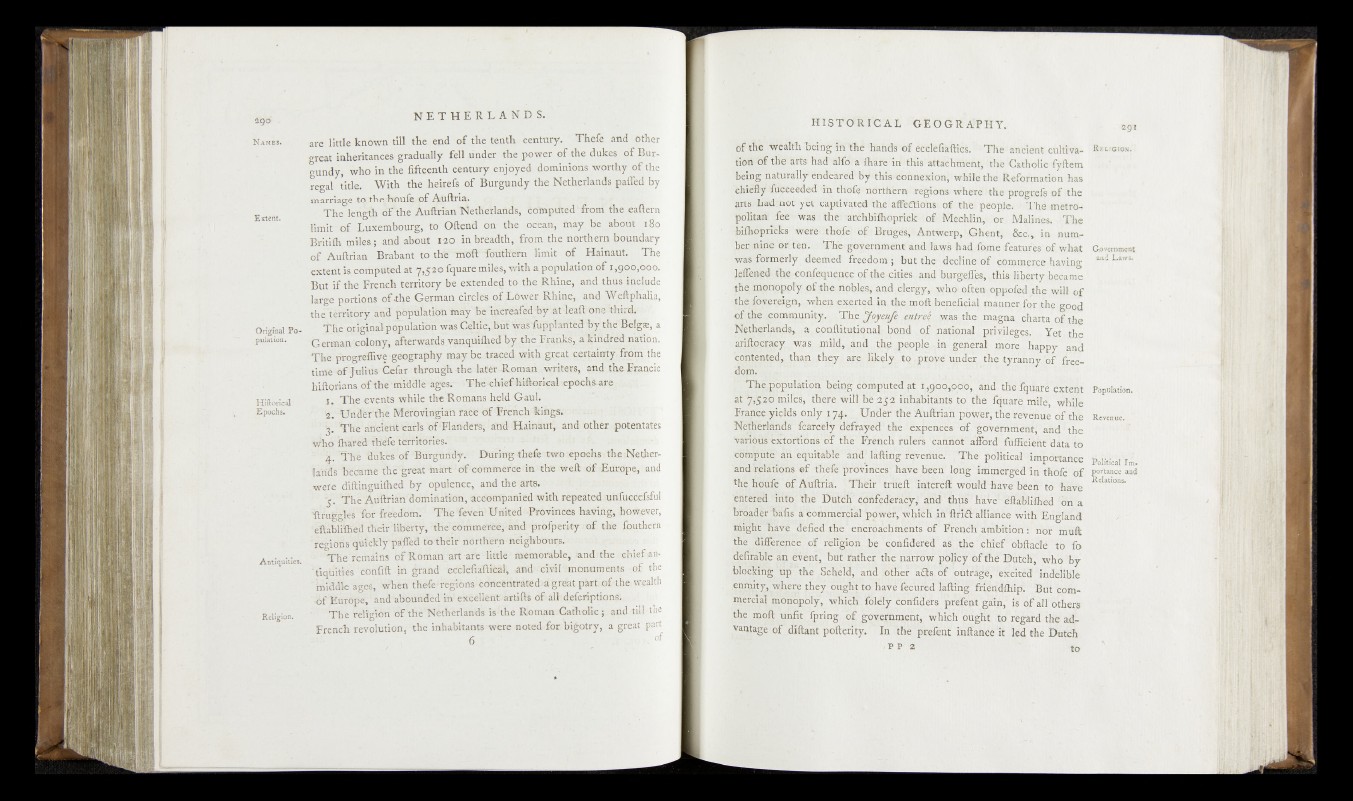
■ « mes/
Extent.
Orignal Eo-
- ; puiâtîGii. .'
Hiftorical
' Epochs. >
Antiquities.
Religion,
are little known till the eftd o f the tenth,, hentury. Thefe and <g|her
great inheritances gradually f e ll^ g d b ; ,the*p0wenpf£|e; duke§‘,pf Burg
u n d y who in .the fifteenth century, enjoyed dominions worthy o lth e
regal title. With the heirefs o f Burgundy the Neth'e^lan^s^affed by
marriage to^he|hpufe,*pf Apftrias. ,
- The length a the A u ftnan'^ethetlahns, computed Ttorri the' eafrern
limit" e f Luxembourg, to'Oftend on the .ocean, thay h e ^ a h o u t » ?
Britilh mjlys add, about I2 0 : m breadth,;from the norther# fb b h d a ry
-of .Auftrian *,B ry a n t.to th^ltro-ft'fmrtiiern f f in |t,o f H a i j ^ t ; f e e
extent is, computed at 7,52.0 fquaremilqs, with a, population o f f , ) ® P 0'
B u t if the French territory be bxtende^to' the Rhine, .and l^ ^ in i lu d e
large portions o f th e < ^ $ i a a f nd W |f e £ l i a ,
theTlrrilory and p 6pufatibn'tnay'be?^creafed;bycat'4eaft'On%4?hird.
^ t y 'orlgiTiApQpulatibn was C e J d c /h u t'w i^ p p ^ a i^ ld 'W th e Belgae, a
-Ger^anSc4 ony,Mterwai4 s _ v ^ j ^ e | 1iy .th e l ^ a ^ k s ," a ^ iM f e t |i^ n .
Tfee progreffive »geography mayheJtraee^xil^h'^g^eaJ: ^erj:ai,r^^nmin the
tirrib'df Jmlras>"C&kr i through -the- kter-Reman.ry0dteF,s, a n d ,th |^ f e c ic
hiftoriana of'the'rmHdle -agesr The-ehM^fl^ri'eal mpochs-arp.. |
,l. The events while the Romans held Gauls 1
’27 Un&r'the N1 CroVinyi^i ritebbf fF?e'Bch4 tifegs^ ' fife
r>^ .v Th'e arictttft-eafls 'cfTkilctefe, aftd--rHainatft, and otherjipotontates
who ihated fhdfe tdrritbrtes.TEsn
’T h e 'dukes'of )Biotgnrfdy.: During thefe .two leposhs <*e jlfetberweft
of Europe, and
.were diftinguifhed b y ' opulence, and thwarts. -
-y *The AuiMa'n'dctoifeatron, acebm'panied Jyith repeated mh&jfgfsfiil
J u g g l e s for freedom. TheTeven United Provinces havings however,
eftablilKed th e irh b e r ty ,th e commerce, and profperity of the fouthera
'regions quickly palled to their northern - neighbours.
The" remains o f Roman art-are little •• memorable, 'and the chief antiquities
‘conlift in grand ecclefiaftical, and ciyil monuments, o f die
middle ages,'when thefe'regions'concentrated-a great part of the wealth
.'o f Europe," and abounded in excellent arti Its of all deferiptions.
: T h e religion of the'Netherlands is the Roman Catholic ; and till the
French revolution, the inhabitants were noted for bigotry, a great part
m h I ■ . . . of
of the wealth bm.-ng'iii'^flie dninds of eeclefiaftics. The abtslent citl&và-
tiod^hf tluihri-s had^dîli^â^âife^i^tëiS'khàGhtiate&ç, The Cathplle ’fyfteto,
being |a u n d lly <?n dear fed B y ^ lé ^ o ib fe ^ o h ^M lfe i the-Reformation has
hht30^«^îlelde<lrïç.'th£îfeïnsâhl:Kbrnï‘ regions! whÊréhthe psogmls sxf ithe
arts.ha’dihet yet eaifrivtSt^lhplaffeifSicfc'st'dÊtth€l people.- '..Thé: mefrch
poltaofi de ^'w a s^M i^^ehbfiibpjibfoie fnK Je chlin, ‘©r. MaliiffS, The
yXfla^pritfcs .were;:thefe) &É BrdgdsRAntvrserp,bGhentj- jn numbeRfni.
rie ë#i|^h:.-T'hergèyeiîîîment; andlkwâ haddèpie features p f ^ h #
W ^ p îm è r ly i dtemled freedom ; tlfut thc^ilecîine ot çorçmgrce having
)affe$gd. t^e o£th^-,citjps, arn} 'hiiray^g, .^ h ^ lih g r ty .h p * ^ ^
ü#d r d 'e r - g y ^ h ^ g ç i ^ onpp&ijihp *wîl,pf
vvjbgja,fe^t'edjijfh tfie## ql|^engfiçiaj, Æie .gpqd
p f tjjn t o r n ^ v j n i t y . ^ ,vwhsphe' magna pbaV.ta fog fo -
N g t h ^ a n ^ a c ^ p ^ iy i^ n a lS b n d q£ national pi ip lo ge^t-- Y.-r' the
iîmffiWY- W% mdd. gg^'d t th^ Jjætqfe. ,in gmer^'more'X'liappy "Jncî
tOnui/j^e îintLr.'mc k rà n n y ïf^ P re c -
’dbiri!'-J.'
f i^ ê ^ o p û k tip n hsingig^^ u l e d V t T a r i d . W ^ . ^ ^ a f e tpv»pr>t
aV 7 2[Q i^ iM j'îliç rè will hc a ^ ï i iæ p h if aX ^ S tim wWe
F^ang&lyiehls ortly 174. y n d ^ ^ e j s u t t t i â X ',p 6 fe ^ jié|i^ÿ^re^^ë ’J f ^
NemérMh&'matcfe'ly defraVea' thè fëxpenbe!s^^sgByfffidient‘‘ and *VhJ
VaMôâHxtorftods'df the Fjènch m e re hanhtih-afford fuffi'eien.t,!data' tb
"cSibphté ad éljiihaBIên ârftf1 lâftifig r^veiîïtê/ . T h e pohticaf-'rmpchtahce
and Relations e f Ineïe' ^ô^ihteê^' Bk^ve jbpen Ibng''' imiriêîilg ^ a ,Sh;ith^fë'’of
'the hihïffe of Auhria. ’'^n»fâ*ttTOÎf',2Ètèferf would -hà+éSftèeir1 to have
’eiîtei1«! fmtb( fh e Dutch' cohfe'd^racy,' a'hd thus h à ^ 'h ifettidÊ ed ^on a
brqàderhaüs a toihmèrcial upwef, whMï ihmriS'àlliâncfe withiEh^lana
migçt have defied the ÆnhTOachmen^ o f French ambition: nor mufk
the ,mnermée of' rSfigîon h e 1 confiae re |a tg^tîie ieB?ef7ôMaêfë''A,tbi:‘‘ïb.
deurable an eVçnt, but r&tKei' th e narroyv'poficy' èfffie Dùtcli^ who h y
blocking tip the ,Seèela,' and Wittier aifts o f ‘o ^ ïr l^ ^ 'è x â te d indelible
eaiï ï i ï Æ r? fhey .ollShï to Üavp Secured laffing.'fr;eifcïfKi{ft’ ■ ^Bul hom-
mercial monopoly,^wh iq h fo lé ly qorificlets prefent gain, îs 'ç fa ll others
the moft unfit fpring o f goyernmjent, w h i ^ h g ^ i ^ ho regard the ad-
vaiitagè o f diftant pofiënty. ' In 'tfie 'p re fen t inffencefit Iej(jl flie Dutch
I P P 2
R e l ig io n .
Gpveraiyienl
and Laws*
Fopulatfc®^
Rcyei^uei
Political Im>
j^oiràjnGë and
Relations.
t a